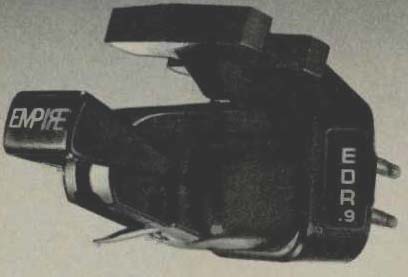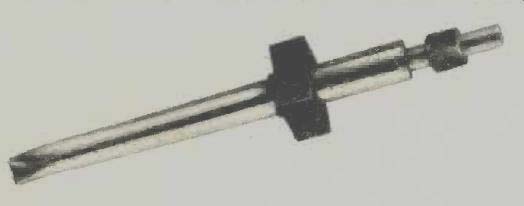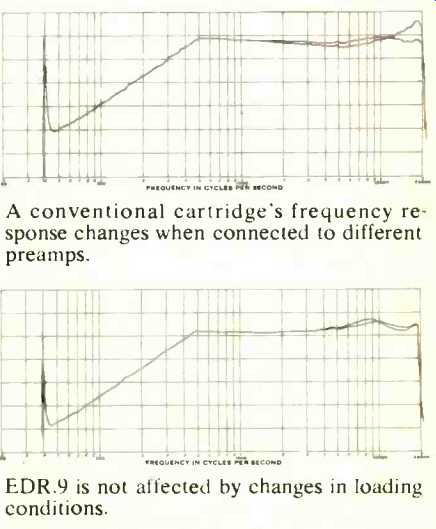
The Phono Cartridge Designed for Today's Audiophile Recordings
Direct-to-Disc and digital recording have added a fantastic new dimension to the listening experience. Greater dynamic range, detail, stereo imaging, lower distortion and increased signal to-noise ratio are just a few of the phrases used to describe the advantages of these new technologies.
In order to capture all the benefits of these recordings, you should have a phono cartridge specifically designed to reproduce every bit of information with utmost precision and clarity and the least amount of record wear.
The Empire EDR.9 is that cartridge. Although just recently introduced, it is already being hailed as a breakthrough by audiophiles, not only in the U.S., but in such foreign markets as Japan, Ger many, England, France, Switzerland and Sweden.
What makes the EDR.9 different?

1. Within the cantilever tube, we added a mechanical equalizer. It serves two purposes: (1) to cancel the natural resonance of the cantilever tube, and (2) to improve the overall transient response of the cartridge. The end result is a stylus assembly that has a mechanically flat frequency response. The frequency response extends from the 20Hz to 35Hz with a deviation of no more than ±1.75 dB. No other magnetic cartridge has that kind of performance. We call this stylus assembly an "Inertially Damped Tuned Stylus" the refinement of which took over 6 years.
2.

Contact area of ordinary Elliptical Diamond. Large contact area of LAC
Diamond. In order to reproduce a groove containing extreme high frequency musical
overtones, the stylus tip must have small enough dimensions to fit within the
high frequency portion of the groove.
Yet, the smaller the stylus tip, the greater the pressure applied to the record surface and the more severe the record wear. In the EDR.9, we have responded to these conflicting requirements by developing a stylus that has the. proper dimensions from side-to-side, a much smaller dimension from front-to-back, and a very large, low pressure degree of contact between stylus and groove top-to-bottom. The net result of this large contact area, which engineers call a "footprint" is that the stylus of the EDR.9 can track musical signals to the limits of audibility and beyond, yet has the lowest record wear of any cartridge presently available. The stylus shape of the EDR.9 is called L.A.C. for "Large Area of Contact”.
3. Conventional cartridges exhibit radical changes in their frequency response when connected to different preamplifiers. This is because the load conditions--the amounts of capacitance and resistance provided by the preamp vary tremendously from one preamp to another, and from turntable to turn table. Consequently, most phono cartridges. even expensive ones, have their frequency response determined essentially by chance, depending on the system they are connected to.
But the electrical elements of the EDR.9 have been designed to remain unaffected by any normal variations in load capacitance or resistance. Thus, the EDR.9 maintains its smooth frequency response and accurate transient-reproduction ability in any music system, irrespective of loading conditions.

------A conventional cartridge's frequency response changes when connected to different preamps.
------EDR.9 is not affected by changes in loading conditions.
Then, as a final test of performance, we listen to every EDR.9 to make certain it sounds as good as it tests. At $200, the EDR.9 is expensive, but then again, so are your records.
For more detailed information and test reports, write to:
Empire Scientific Corp.
Garden City, NY 11530 EMPIRE

(Source: Audio magazine, May 1980)
Also see:
Empire Scientific EDR.9 phono cartridge (advertisement, Sept. 1979)
Empire Scientific EDR.9 phono cartridge (Feb. 1979)
Empire EDR.9 Magnetic Phono Cartridge (Equip. Profile, Sept. 1979)
Empire Scientific phono cartridges (Nov. 1978)
= = = =